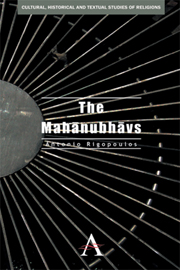Book contents
- Frontmatter
- Contents
- Dedication
- 1 Introduction
- 2 The Early Historical Background and the Mahānubhāvs' Foundational Texts
- 3 The Five Manifestations of the Supreme God Parameśvar
- 4 Elements of Mahānubhāv Doctrine
- 5 Mahānubhāvs' Practice: Devotion and Asceticism
- 6 Mahānubhāvs and Other Religions
- Bibliography
3 - The Five Manifestations of the Supreme God Parameśvar
Published online by Cambridge University Press: 05 May 2012
- Frontmatter
- Contents
- Dedication
- 1 Introduction
- 2 The Early Historical Background and the Mahānubhāvs' Foundational Texts
- 3 The Five Manifestations of the Supreme God Parameśvar
- 4 Elements of Mahānubhāv Doctrine
- 5 Mahānubhāvs' Practice: Devotion and Asceticism
- 6 Mahānubhāvs and Other Religions
- Bibliography
Summary
The monotheists Mahānubhāvs believe in five manifestations of the One God Parameśvar, also known as Īśvar, ‘Lord’, or Para ‘Supreme’. He is the sole source of liberation to whom is directed exclusive devotion. Even though the Sūtra-pāṭh (10.212; 11.18-19) states that there are and have been an infinite (ananta) number of manifestations of Parameśvar —divine, human, as well as animal— the Mahānubhāvs stick to only five avatārs. These are the five Krssas (panca-kṛṣṇas) comprising two deities —Kṛṣṇa himself and Dattātreya— and three human figures: Cakradhar, the movement's founder, Gusdam RāüỊ, Cakradhar's Mguru, and Cāṅgdev RāüỊ, Gusdam RāüỊ's guru. The avatārs of Parameśvar are «Brahman with hands and feet» (Sūtra-pāṭh 8.18). Mahānubhāvs are therefore exclusivists: Parameśvar alone via the pañca-kṛṣṇas can save the souls (jīvas) entangled in transmigration. Precisely for this reason, the ‘pres- ence’ (sannidhān) of a divine manifestation and the coming in contact with an avatār of Parameśvar is understood to be absolutely essential for attaining deliverance.
The first explicit mention of the pañca-kṛṣṇas is found in the panca-nāma and pañca-kṛṣṇa sections of the Sūtra-pāṭh. These sections, however, were not comprised in the earliest versions of the sacred text since they were added when Kavīśvar, in the early fourteenth century, reconstructed the Sūtra-pāṭh.
- Type
- Chapter
- Information
- The Mahanubhavs , pp. 33 - 60Publisher: Anthem PressPrint publication year: 2011



